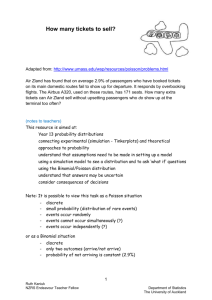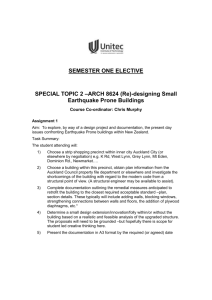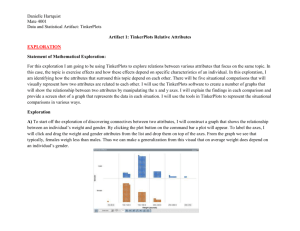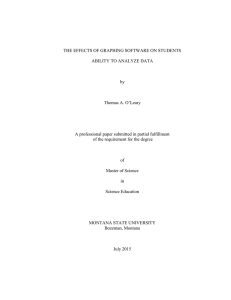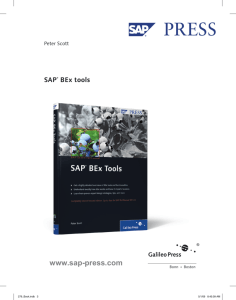Probability Powerpoint Level 1
advertisement
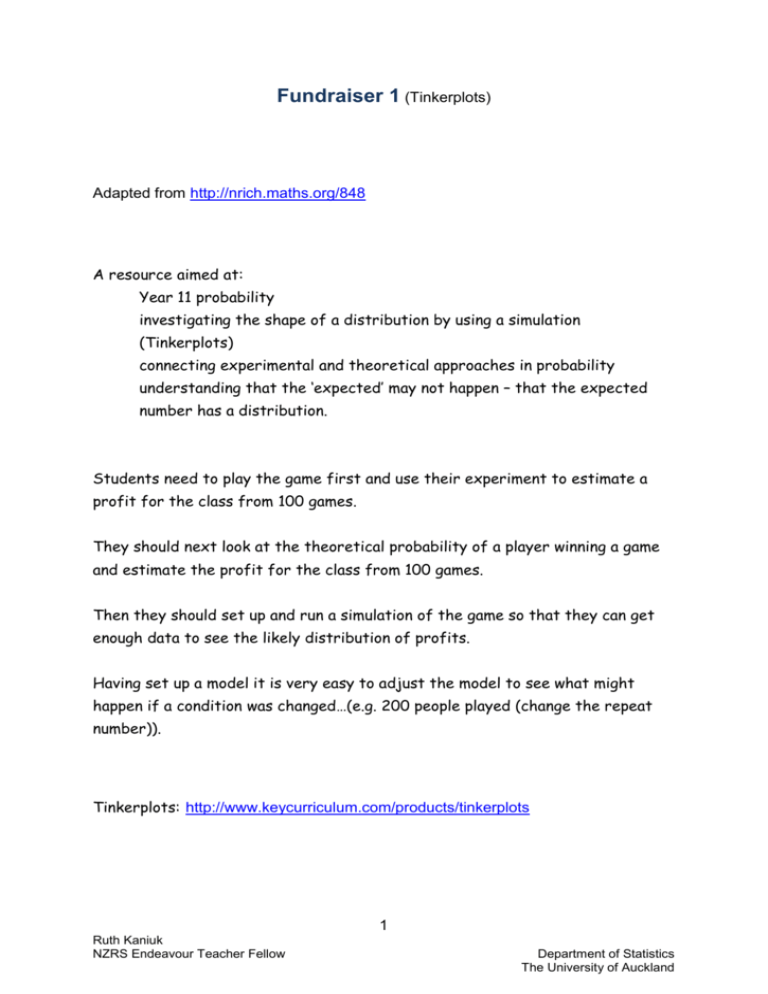
Fundraiser 1 (Tinkerplots) Adapted from http://nrich.maths.org/848 A resource aimed at: Year 11 probability investigating the shape of a distribution by using a simulation (Tinkerplots) connecting experimental and theoretical approaches in probability understanding that the ‘expected’ may not happen – that the expected number has a distribution. Students need to play the game first and use their experiment to estimate a profit for the class from 100 games. They should next look at the theoretical probability of a player winning a game and estimate the profit for the class from 100 games. Then they should set up and run a simulation of the game so that they can get enough data to see the likely distribution of profits. Having set up a model it is very easy to adjust the model to see what might happen if a condition was changed…(e.g. 200 people played (change the repeat number)). Tinkerplots: http://www.keycurriculum.com/products/tinkerplots 1 Ruth Kaniuk NZRS Endeavour Teacher Fellow Department of Statistics The University of Auckland Fundraiser 1 (Tinkerplots) The school is having a fundraising fair. Each class is responsible for organising one activity. Bex suggests that her class run a game as follows. THE GAME: Start with a counter on the star in the grid below. Toss a coin. Move up for Head, left for Tail. Keep tossing coin until you are either off the board (lost) or you have won by reaching the top left square on the grid. Win! QUESTION I wonder: If it costs $2 to play and the player gets $5 if she/he wins (a gain of 5-2 = $3), will Bex’s class make a profit, assuming 100 people each play the game once? Do you think that Bex’s class will make a profit? How much? Could they lose money? How could you find out? 2 Ruth Kaniuk NZRS Endeavour Teacher Fellow Department of Statistics The University of Auckland PLAN To start to answer the question, first play the game. How will you play the game? How many times will you play the game? What will you record? How will you work out whether Bex’s class will make a profit? DATA Carry out your experiment and record your data in a suitable format. ANALYSIS Draw an appropriate display to show your data. Summarise your data. 3 Ruth Kaniuk NZRS Endeavour Teacher Fellow Department of Statistics The University of Auckland Estimate the probability of winning a game, based on your experiment. Estimate the profit that Bex’s class might make if 100 people each played the game once, based on your experiment. Draw a diagram that shows a model of this situation (tree diagram or another appropriate diagram). Calculate a theoretical probability of winning a game. Use this to estimate the profit that Bex’s class would make from 100 people playing. CONCLUSION I estimate that Bex’s class will 4 Ruth Kaniuk NZRS Endeavour Teacher Fellow Department of Statistics The University of Auckland Plan 2 Now use Tinkerplots to gather a larger sample of data for this situation. Write a brief description of a simulation that you can perform using Tinkerplots to help you answer your question. Identify each of the following in your description: The model: what will you use in the sampler what are the possible outcomes and how will they look in Tinkerplots? How will you decide if the game is ‘won’ or ‘lost’? sampling with or without replacement? A single trial: what is one trial (DRAW = how many trials for 1 simulation of 100 people playing the game (RUN = Result(s) being collected DATA 2 Set up the simulation in Tinkerplots, run it once and check that it is doing what you think it should. Collect the number of ‘wins’ and ‘loses’ for the 100 games. Write a formula for the amount of profit from the 100 games. Graph the profit. Collect the profits from many lots of 100 games. Watch the distribution of profit grow. Sketch that distribution here: 5 Ruth Kaniuk NZRS Endeavour Teacher Fellow Department of Statistics The University of Auckland ANALYSIS 2 How much profit is it likely that Bex’s class will make? Would this be a good fundraiser for the class to organise? Why? CONCLUSION 2 I estimate that Bex’s class will 6 Ruth Kaniuk NZRS Endeavour Teacher Fellow Department of Statistics The University of Auckland WHAT IF…. Investigate the likelihood of Bex’s class making a profit if a different number of people play the game (what happens if fewer people play, what happens if more people play) OR Investigate a suitable prize and cost to play that so that the risk of Bex’s class losing money is reduced (and the cost to play is small enough that people are likely to play) OR Investigate possible profit from the game using different size grids [square eg 4x4 or rectangular grids] 7 Ruth Kaniuk NZRS Endeavour Teacher Fellow Department of Statistics The University of Auckland Tinkerplots help sheet The model: what will you use in the sampler A mixer with two marbles labelled H and T to represent the two sides of a coin. what are the possible outcomes and how will they look in Tinkerplots? How will you decide if the game is ‘won’ or ‘lost’?. The outcomes will be a string of four coin tosses (a string of four H/T); a count of the number of H and/or a count of the number of T, and a decision as to whether the player won or lost the game sampling with or without replacement? With replacement - each coin toss can have two outcomes (H or T) A single trial: what is one trial (DRAW = 4 to represent the tossing of 4 coins. It does not matter if the player is off the board before the fourth toss. how many trials for 1 simulation of 100 people playing the game (Repeat = 100) Result(s) being collected from each trial win/lose Drag a sampler onto the page. Use a mixer with two marbles. Label them H and T. Draw = 4. Rename the four Attributes ‘toss1’ to ‘toss4’. Run – check whether the simulation is doing what you think it should. In Results table, head up a new column ‘result’. Right click on coloured bar under column heading and ‘edit formula’. Write a formula such as the one below to decide win or lose. 8 Ruth Kaniuk NZRS Endeavour Teacher Fellow Department of Statistics The University of Auckland Change Repeat to 5 Run to check that the simulation is doing what you think it should. Highlight ‘result’ column and drag a plot onto the page. Pull a circle to the right to separate ‘win’ and ‘lose’. Stack. Count (N). Collect statistic for ‘win’ and ‘lose’ ( the ‘collect statistic’ will be found by right clicking the number in the plot) In History of result table, head up a new column ‘profit’. Edit formula to calculate the profit. [ e.g. profit = 2* count_Result_lose – 3* count_Result_win] Run to check that your formula is working correctly! Highlight the profit column and drag a plot onto the page. Pull a circle to the right to fully separate. Bin width = 0. (to get bin width and adjust min/max on axis, double click a number on the x-axis) Delete all history cases. (under options, History of results table) Change Repeat to 100. Run a few times and check that the simulation is doing what you think it should and make any necessary adjustments. Collect sufficient runs of 100 trials (change the number next to the ‘collect’ box in history of results table, then click ‘collect’) so that the distribution of profits from 100 games is clear and you are confident to make a conclusion. [let students experiment with how many is ‘enough’!] Use the divider and counts- percentages/proportions to estimate the chance of making a profit from 100 games. Display the mean profit (averages) from 100 games. 9 Ruth Kaniuk NZRS Endeavour Teacher Fellow Department of Statistics The University of Auckland This work is supported by: The New Zealand Science, Mathematics and Technology Teacher Fellowship Scheme which is funded by the New Zealand Government and administered by the Royal Society of New Zealand and Department of Statistics The University of Auckland 10 Ruth Kaniuk NZRS Endeavour Teacher Fellow Department of Statistics The University of Auckland
